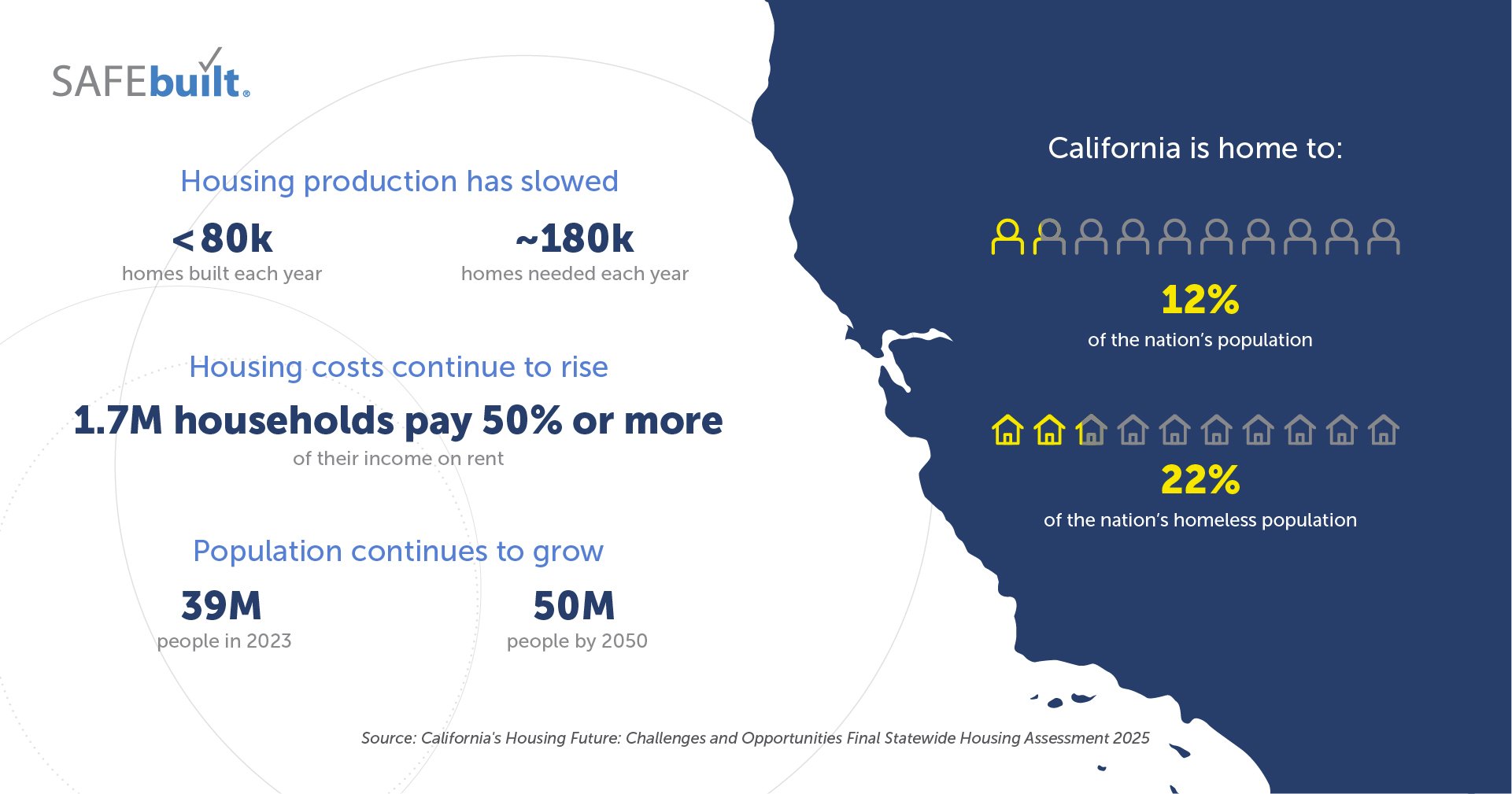The California housing crisis, which has become unmatched across the nation, has made it difficult for communities to grow and sustain healthy communities.
But as the State continues to roll out legislation to help address this widespread issue, local government agencies may struggle to stay on top of the changes.
Let’s explore why this legislation is coming into effect and how to manage your community in the face of these changes.
More than a housing shortage
A housing shortage is more than just not enough houses being built — it’s a multi-pronged issue.![]()
What changes are making the most impact?
As the State continues to roll out and evolve, government agencies may struggle to stay on top of the cascading legislation from the State Department. As we work with communities across California, Interwest (a SAFEbuilt Company) is seeing the most change due to the following legislation.
Streamlined reviews to boost housing (SB35)
Effective January 1, 2018, SB35 streamlines the review process for qualifying multi-family housing construction in California counties and cities that fail to build enough housing to meet state-mandated housing construction requirements.
Eligible developments must also agree to
- Pay prevailing wages during construction
- Provide a prescribed minimum percentage of units that are affordable to low- or moderate-income households upon completion
- Comply with objective development standards of the permitting jurisdictions
Interwest has assisted municipalities across the state with developing SB35 review criteria, preparing multi-family objective design standards, and processing eligible projects.
Restricted design standards (SB330)
For development applications submitted after January 1, 2020, SB330 restricts local agencies from adopting and, in some cases applying subjective design standards in the review of housing projects. The law creates a streamlined building permit level approval process for infill projects with two or more residential units in localities that have failed to produce sufficient housing to meet state regional housing goals.
The streamlined approval process requires some level of affordable housing to be included in the housing development. The developer also must demonstrate that the development meets a number of requirements. Interwest staff has assisted local cities and counties with processing eligible projects.
Accessory Dwelling Units (ADUs)
Various laws have been enacted, expanding the rights of homeowners to construct ADUs and Junior ADUs (500 square foot units) on residential properties. Since 2016, California has pre-empted local zoning regulations and established state criteria allowing both attached and detached ADUs and Junior ADUs on all residentially zoned properties.
Interwest staff has assisted local agencies with developing ordinances and program materials to comply with California’s new regulations. Additionally, we have helped expedite ADU permit reviews.
Division of residential lots (SB9)
This law became effective on January 1, 2022, and allows existing residential lots to be subdivided regardless of local regulations on minimum lot sizes (provided one of the units is owner-occupied and the lot provides adequate low- or moderate-income rental units).
SB9 also expands the ability to construct second dwelling units beyond those allowances for Accessory Dwelling Units.
Interwest staff has assisted local agencies in updating zoning ordinances to implement these new requirements and has practical experience implementing the new requirements.
Housing allowed on commercially zoned lots (SB6/AB2011)
SB6 and AB2011 take effect on July 1, 2023. While subject to some limitations, they will allow housing where office, retail, or parking are principally permitted uses.
AB2011 will provide developers with a ministerial level (building permit only) review that is exempt from the State’s environmental review for qualifying Below Market Rate and Mixed-Income Projects that pay prevailing wages during construction. Senate Bill 6 (SB6) allows residential use of commercially zoned property without requiring a rezoning if affordable housing units are provided.
Interwest staff is ready to assist agencies in developing materials to comply with these new requirements.

Staying on top of continual housing code changes
While adding housing across California is the ultimate goal, local communities are facing additional challenges in the face of growing communities, including inadequate transportation and too few local resources to accommodate the quick expansion of their population.
![]()
While communities can revisit their regulations to create more ideal neighborhoods for development, government agencies are not ultimately responsible for building the homes that the State is looking to produce.
So, what can you do in the meantime?
Adapting to state legislation
While there’s no doubt that the need for housing continues to escalate, implementing these changes can be time-consuming.
That’s where we can help.
Interwest helps California communities throughout building projects, from the moment a developer comes to town, to the day the homeowner moves in. That includes:
- Fielding permits
- Providing certified plan reviewers and inspectors
- Improving responsive review processes to attract developers
In addition to building department services, we can also help communities with:
- Staying up to date on state law and making sure regulations are reflected in your local agency’s goals as much as possible
- Revising comprehensive plans to simplify building in your community (and attract developers)
- Protecting the unique aspects of your community while making room for necessary growth
- Preparing for the future by identifying where your community could benefit from additional growth and ensuring that your public works department is in sync to make your plans work together for the benefit of the community


